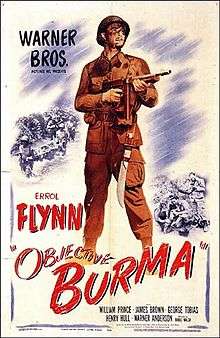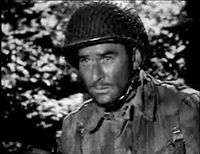Objective, Burma!
| Objective, Burma! | |
|---|---|
 Original film poster | |
| Directed by | Raoul Walsh |
| Produced by | Jerry Wald |
| Written by | Alvah Bessie (story) |
| Screenplay by |
Ranald MacDougall Lester Cole |
| Starring |
Errol Flynn James Brown |
| Narrated by | Truman Bradley |
| Music by | Franz Waxman |
| Cinematography | James Wong Howe |
| Edited by | George Amy |
| Distributed by | Warner Bros. |
Release dates |
|
Running time | 142 min |
| Country | United States |
| Language | English |
| Box office | 2,635,192 admissions (France)[2] |
Objective, Burma! is a 1945 war film which was loosely based on the six-month raid by Merrill's Marauders in the Burma Campaign during the Second World War. The film, made by Warner Brothers immediately after the raid, was directed by Raoul Walsh and starred Errol Flynn.
Plot

A group of United States Army paratroopers led by Captain Nelson (Errol Flynn) are dropped into Burma to locate and destroy a camouflaged Japanese Army radar station that is detecting Allied aircraft flying into China. For their mission, they are assigned Gurkha guides, a Chinese Army Captain and an older war correspondent (Henry Hull) whose character is used to explain various procedures to the audience.
The mission is an overwhelming success as the 36-man team quickly take out the station and its personnel. But when the airborne troops arrive at an old airstrip to be taken back to their base, they find the Japanese waiting for them at their rendezvous site. Captain Nelson makes the hard decision to call off the rescue planes, and hike out on foot.
To reduce the likelihood of detection, the group then splits up into two smaller units to meet up at a deserted Burmese village. But when Nelson arrives at the meeting place, he finds that the other team had been captured, tortured and mutilated by the Japanese. Only Lt. Jacobs survives, and he too dies after telling Nelson what had happened. The surviving soldiers are then attacked and are forced again to retreat into the jungle. The men must then cross the swamps in their attempt to make it back to safety through enemy-occupied jungle.
Fighting an almost constant rearguard action, Nelson's paratroopers also succeed as decoys leading Japanese troops away from the site of the British 1944 aerial invasion of Burma.
Cast
- Errol Flynn as Captain Nelson
- James Brown as SSgt. Treacy
- William Prince as Lt. Sid Jacobs
- George Tobias as Cpl. Gabby Gordon
- Henry Hull as Mark Williams (American News correspondent)
- Warner Anderson as Col. J. Carter (CO, 503rd Parachute Infantry)
- John Alvin as Hogan
- Mark Stevens (credited as Stephen Richards) as Lt. Barker
- Richard Erdman as Pte. Nebraska Hooper
- Erville Alderson as General Stilwell, (uncredited)
- Rodd Redwing as Gurkha Sergeant, (uncredited)
- Hugh Beaumont as Captain Hennessey (uncredited)
Production
Producer Ranald MacDougall had been a creator and co-writer of the CBS radio series The Man Behind the Gun that was awarded a 1942 Peabody Award.[3] He had been contracted to Warner Brothers, with this his second film after uncredited work on Pride of the Marines.
Jerry Wald later claimed he got the idea for doing a film set in Burma in Christmas 1943, feeling that that theatre of the war would soon be active, and hoping the movie could be made and released before then.[4] The film was announced in January 1944, with Wald and Walsh attached. Errol Flynn was already being discussed as the star.[5] Franchot Tone was mentioned as a possible co star.[6] Filming began in April 1944.[7] By this stage the Allied campaign had already started in Burma, meaning Wald was unable to do a Casablanca style cashing in on the film's release.[4]
The film was made with authentic World War II American military material, aircraft and gliders, due to their availability.[8] Producer Jerry Wald acknowledged that the plot bore a significant similarity to the 1940 film Northwest Passage.[9]
Location
Exteriors were shot at the Los Angeles County Arboretum and Botanic Garden, California. Filming began on May 1, 1944 and was scheduled for 60 days. But shooting required more than 40 extra days due to bad weather and constant script changes.
The movie also contains a large amount of actual combat footage filmed by U.S. Army Signal Corps cameramen in the China-Burma-India theatre[10] as well as New Guinea.[11]
Reception
Reviews of Objective, Burma! were generally favorable, although it was commonly faulted as being too long. The New York Times wrote: "This is without question one of the best war films yet made in Hollywood. There are no phony heroics by Errol Flynn or any of the other members of a uniformly excellent cast. These boys conduct themselves like real soldiers and even the newspaper correspondent is a credit to the craft. The Warners have erred only in the film's excessive length. It runs approximately two hours and twenty minutes, or roughly thirty minutes more than appears to be absolutely necessary."[12] Variety noted: "The film has considerable movement, particularly in the early reels and the tactics of the paratroopers are authentic in their painstaking detail. However, while the scripters have in the main achieved their purpose of heightening the action, there are scenes in the final reels that could have been edited more closely."[13] Harrison's Reports wrote: "Very good! It ranks with the best of the war melodramas yet produced ... While the action holds one's interest all the way through, a cut of ten to fifteen minutes in the running time would not affect its dramatic punch."[14] Film Daily wrote: "The picture impresses with its air of authenticity and the vivid realism that has gone into the telling of its story, and it possesses almost unremitting action crowded with the starkest of drama ... The primary fault of the film is that it is dragged out beyond all reason. There is much repetitious material that could be cut out to the improvement of the film."[15]
Objective, Burma! was one of the most popular movies of 1945 in France.[2]
Controversies
Even though it was based on the exploits of Merrill's Marauders, Objective Burma was withdrawn from release in the United Kingdom after it infuriated British Prime Minister Winston Churchill and drew protests about the Americanization of an almost entirely British, Indian and Commonwealth conflict.[16][17] An editorial in The Times said:
It is essential both for the enemy and the Allies to understand how it came about that the war was won ... nations should know and appreciate the efforts other countries than their own made to the common cause.
Objective, Burma! was not put on general release in the UK until 1952 when it was shown with an accompanying apology. The movie was also banned in Singapore although it was seen in Burma and India.[18][19]
There were also objections to Errol Flynn playing the hero as, despite being Australian, he had stayed in Hollywood during the war, unlike actors like David Niven or James Stewart.[20][21] Flynn, however, had tried to enlist but had been declared medically unfit for military service. His studio suppressed the news of his medical problems to preserve his public image.
Nominations
The film was nominated for three Academy Awards in 1945:
References
Notes
- ↑ "Objective, Burma!". American Film Institute. Retrieved March 10, 2016.
- 1 2 "French box office information 1945." Box Office Story. Retrieved: November 25, 2015.
- ↑ Dunning 1998, pp. 430–431.
- 1 2 Stanley, Fred. "Out of the Hollywood hopper: MGM's mMusical Ssplurge; O & J hit the jackpot, Other items." The New York Times, May 7, 1944, p. X3.
- ↑ "Special to The New York Times: Screen News here and in Hollywood; Cary Grnt to star in farce at RKO; 'Song of Bernadette' opens today at Rivoli." The New York Times, January 26, 1944, p. 23.
- ↑ Hopper, Hedda. "Looking at Hollywood." Chicago Daily Tribune, April 14, 1944, p. 20.
- ↑ "Special to The New York Times: Screen News here and in Hollywood; M-G-M to co-star Garson and Tracy; Three theatres to show premieres today." The New York Times, April 25, 1944, p. 16.
- ↑ Cusskelly, Ron. "Limping Lizzie- Movie star." The Lockheed Files. Retrieved: May 5, 2013.
- ↑ Holston 1994, p. 84.
- ↑ Heenan, T/Sgt Arthur. " I-B Signal Corps Shots In 'Objective, Burma!': Myitkyina operations presented." Delhi, India: India-Burma Theater Roundup, Vol. III, No. 31. Reg. No. L5015, April 12, 1945.
- ↑ "Waxman: Objective Burma." ClassicsOnline. Retrieved: May 5, 2013.
- ↑ "Movie Review: Objective, Burma!". The New York Times. January 27, 1945. Retrieved March 10, 2016.
- ↑ "Film Reviews". Variety. New York: Variety, Inc.: p. 10 January 31, 1945.
- ↑ "'Objective Burma' with Errol Flynn". Harrison's Reports: p. 14. January 27, 1945.
- ↑ "Reviews". Film Daily. New York: Wid's Films and Film Folk, Inc.: p. 4 January 29, 1945.
- ↑ "British ban Objective Burma." Army News (Darwin, NT: 1941–1946), September 27, 1945, p. 1. via National Library of Australia. Retrieved: March 25, 2012.
- ↑ Warners suspend 'Burma' in Britain: Film criticized by Public on grounds that it ignored the Fourteenth Army." The New York Times, September 26, 1945, p. 27.
- ↑ "Film to be banned at Singapore." The Canberra Times (ACT), January 17, 1948. via National Library of Australia. Retrieved: March 25, 2012.
- ↑ Thomas et al. 1969, p. 140.
- ↑ Hobbes 2003
- ↑ " 'Great Escape' makers turned facts into fiction." The Times, March 25, 2009.
Bibliography
- Dunning, John. On the Air: The Encyclopedia of Old Time Radio. Oxford, UK: Oxford University Press, 1998. ISBN 978-0-19507-6-783.
- Hobbes, Nicholas. Essential Militaria: Facts, Legends, and Curiosities About Warfare Through the Ages. London: Atlantic Books, 2003. ISBN 978-1-84354-229-2.
- Holston, Kim R. The English-Speaking Cinema: An Illustrated History, 1927-1993. Jefferson, North Carolina: McFarland & Company, 1994. ISBN 978-0-89950-8-580.
- Thomas, Tony, Rudy Behlmer and Clifford McCarty. The Films of Errol Flynn. Sacramento, California: Citadel Press, 1969.
External links
- Objective, Burma! at the Internet Movie Database
- Objective, Burma! at AllMovie
- Objective, Burma! at the TCM Movie Database
- Objective, Burma! at the American Film Institute Catalog
- Review of film at Variety
- Downloadable trailer in different formats